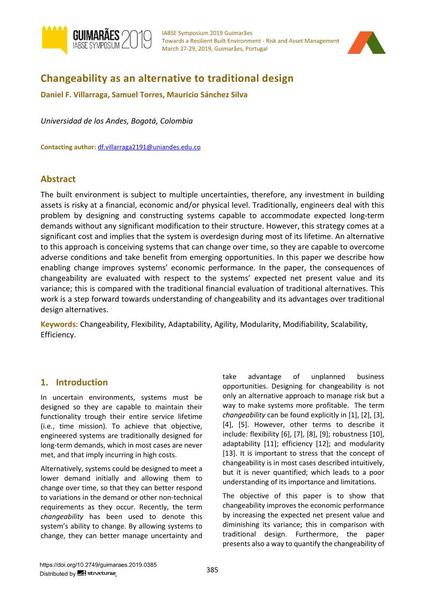Changeability as an alternative to traditional design

|
|
|||||||||||
Détails bibliographiques
| Auteur(s): |
Daniel F. Villarraga
(Universidad de los Andes, Bogotá, Colombia)
Samuel Torres Rincón (Universidad de los Andes, Bogotá, Colombia) Mauricio Sánchez Silva (Universidad de los Andes, Bogotá, Colombia) |
||||
|---|---|---|---|---|---|
| Médium: | papier de conférence | ||||
| Langue(s): | anglais | ||||
| Conférence: | IABSE Symposium: Towards a Resilient Built Environment Risk and Asset Management, Guimarães, Portugal, 27-29 March 2019 | ||||
| Publié dans: | IABSE Symposium Guimarães 2019 | ||||
|
|||||
| Page(s): | 385-391 | ||||
| Nombre total de pages (du PDF): | 7 | ||||
| DOI: | 10.2749/guimaraes.2019.0385 | ||||
| Abstrait: |
The built environment is subject to multiple uncertainties, therefore, any investment in building assets is risky at a financial, economic and/or physical level. Traditionally, engineers deal with this problem by designing and constructing systems capable to accommodate expected long-term demands without any significant modification to their structure. However, this strategy comes at a significant cost and implies that the system is overdesign during most of its lifetime. An alternative to this approach is conceiving systems that can change over time, so they are capable to overcome adverse conditions and take benefit from emerging opportunities. In this paper we describe how enabling change improves systems’ economic performance. In the paper, the consequences of changeability are evaluated with respect to the systems’ expected net present value and its variance; this is compared with the traditional financial evaluation of traditional alternatives. This work is a step forward towards understanding of changeability and its advantages over traditional design alternatives. |
||||
